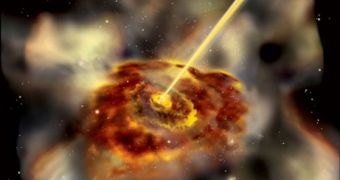Although the observable Universe is mostly void, despite the general belief most of that void is filled with either energy or matter, except for certain strange structures called textures which seem to be having none of the two. High or low energy elementary particles are emitted in all directions by galaxies, quasars or stars. Scientists have ventured upon finding the sources of the most energetic particles in space.
The most energetic particles, studies show, are emitted by quasars at the center of galaxies. Quasars are a class of supermassive black holes, situated in locations with high densities of matter, such as the center of galaxies. Black holes have a bad habit of swallowing everything in their path, light and matter and when they accrete large clouds of molecular clouds, they create what is known as an accretion disk, which is a large disk of hot gas spiraling the black hole and emitting high levels of energy.
Earth is constantly being bombarded with high levels of energetic particles, mostly coming from the Sun and the surrounding space and a large part of them is absorbed by the atmosphere. The Sun emits generally low energy cosmic rays and exploding stars medium energy particles, but until now researchers haven't been able to pinpoint the exact location from which the highest energy cosmic rays are coming from.
Some of these particles contain as much energy as a baseball pitcher's fast ball, but packed into a volume a hundred million times smaller, such as a lone proton. These high energy particles usually point towards the point of origin, back to their sources and seem to come from areas of the sky which are known to contain massive black holes located in galactic nuclei, nevertheless this evidence is not enough proof that the galactic nuclei are their true sources.
Miguel Mostafa of the University of Utah in Salt-Lake City thinks that these sources of high-energy particles have already been discovered, bringing scientists one step closer to understanding the physical process through which particles are being accelerated to ultrahigh energies.
Although black holes swallow large amounts of matter, when they are not 'feeding' they barely give off any energy; but when they are 'feeding' sucking large clouds of gas swirling matter they also send out high-speed jets of plasma. Though telescopes cannot see directly the high-energy particles coming from space, they can be detected as they enter the Earth's atmosphere, giving off a brief flash of light and triggering emissions of hundreds of other particles as they 'rain' down to the planets' surface.
Of the millions of cosmic rays that have been observed only 27 of these were reported as to have highest energy levels.
By comparing the directions from which cosmic rays seemed to come from, with over 300 galactic nuclei locations within about 325 million light-years from Earth, they have found that 20 of the 27 cosmic ray events were coming from active galactic nuclei, statistics showing that there is a good chance that these are the true sources.

 14 DAY TRIAL //
14 DAY TRIAL //